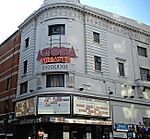@sohoplace
2022 establishments in EnglandTheatres completed in 2022Theatres in the City of WestminsterUse British English from October 2022West End theatres
@sohoplace is a West End theatre operated by Nimax Theatres. It is on the site of the previous London Astoria, as part of development around the Elizabeth line's Tottenham Court Road station. It is the first purpose-built West End theatre to be opened in 50 years. It opened on 15 October 2022, with a production of the play Marvellous.
Excerpt from the Wikipedia article @sohoplace (License: CC BY-SA 3.0, Authors).@sohoplace
Sutton Row, London Bloomsbury
Geographical coordinates (GPS) Address Nearby Places Show on map
Geographical coordinates (GPS)
| Latitude | Longitude |
|---|---|
| N 51.515833333333 ° | E -0.13055555555556 ° |
Address
Sutton Row
W1D 4NR London, Bloomsbury
England, United Kingdom
Open on Google Maps








